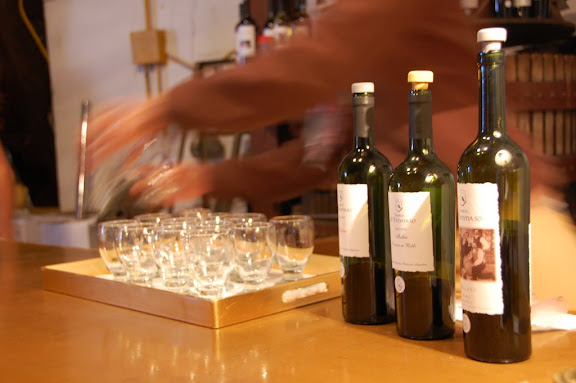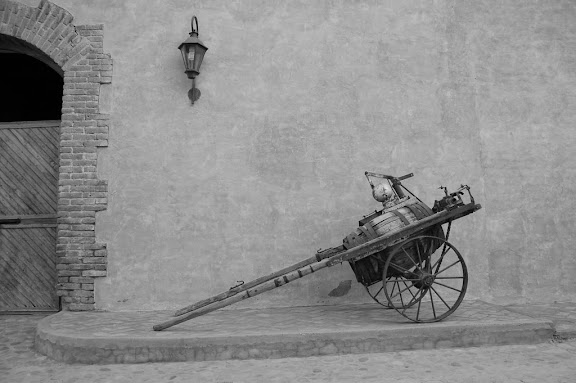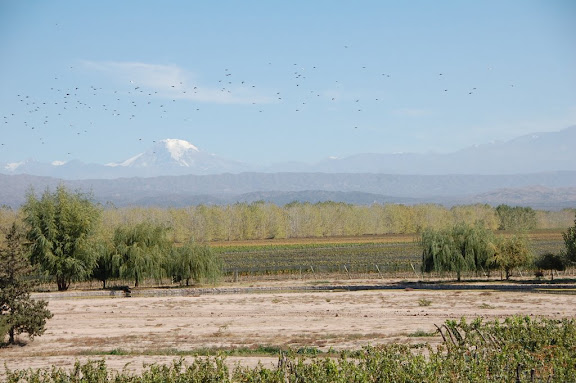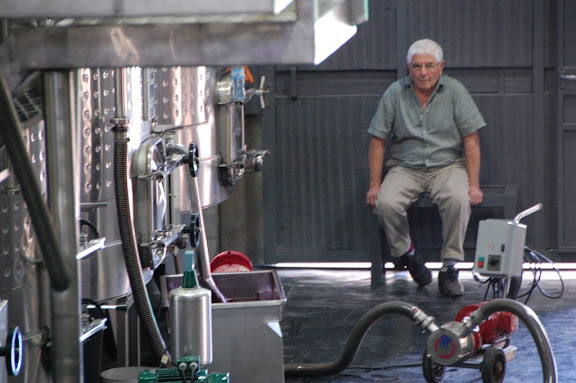After a quick taste of Chile, we hadn´t had enough of Argentina, so we hit the road for a full day bus ride through the Andes to Mendoza. I had high hopes for Mendoza and it filled every expectation and more. Mendoza has all the benefits of a big city: clean and well kept, tree lined well-planned streets, accessbility to goods, and services (mani/pedi!!), nice plazas and statues, nice restaurants and hotels, and to top it off a huge park with sycamore trees, pathways and a decent man made lake (excellent running!!). But it also has a very small and spacious feeling about it, with its excellent urban planning and quaint neighborhoods, it doesn´t feel cramped or polluted like many of the big cities we´ve seen. Then throw in the given amazing qualities of the Argentine people - friendly, outgoing, and they know how to enjoy life - and there you have Mendoza. Plus, the weather is great - mostly sunny and dry year round, its actually in the desert so they have to route all their water from the Rio Mendoza. McLure, being from a Arizona, was particularly fascinated by their irrigation system. I never knew what a passion he had for irrigation! Anyway, they have devised a system where they have open air cement canals of water running on both sides of every street block - kinda cool and relaxing.
Our first night there we went to a great wine bar, Vines of Mendoza - highly reccommended, where we got a great intro the Argentine wine. Our wine bartender taught us tons about the region and its long history as the wine region of Argentina, where many Italian immigrants came in the 1800´s and worked in the wineries as the wine industry flourished, and brought their traditions and culture from Europe. Espcially interesting to me, she said that she felt a stronger heritage to Italy than Spain and that many do in Aregentina. I never realized just how Italian these people are - but its true. They speak in a sing-song much like Italians, Pizza and helado everywhere, very loud, friendly outgoing.. it all adds up. From living in spain, I also defintely note their Spanish influence - a perfect mix if you ask me.
First day in Mendoza we started with a rafting trip in Pedrillos, the base of the mountains that sit to the west of the region. Although the water levels were low, we still had a blast and the views along the river were reason enough for the trip. The beautiful desert rocks and brush that lined both sides of the river were breathtaking. Good thing the water wasn´t rough because I was looking around just much as I was rowing. (Unfortunately no pics.) Diego, our excellent, friendly Mendozan guide, also made the trip. He´ll be guiding rafting trips in 2011 in Colorado, he told me he´s waiting 5 years, yes 5, to get his USA visa request accepted. I had no idea how hard we make it for them!!
Of course, the highlight of Mendoza for me was wine tasting and winery touring. Its fall in Aregentina right now, harvest just finished in April, and so it was a perfect time to see the vines in their fall colors and the wineries in the first steps of the (post grape) wine making process. We spent one day bike riding through the Maipu Valley (the birthplace of wine making in Argentina), stopping, touring, and tasting along the way - approximiately 10 miles out and back along the route. Defintely not as developed as the roads in Napa and Sonoma, so the huge trucks whizzing by us on the narrow road added to the adventure, especially after the third and fourth wineries. My favorites were the small, family owned initimate wineries that held a strong sense of tradition and meaning in the wine making process - Carinae and Familia Di Tomasso was one of those. Quite a contrast to some of the large wineries that are owned by foriegn ¨groups¨ like Trapiche, where the sense of tradition and pride has been moved aside for the financial benefit of large corporate investors.



The second day we joined a guided tour of 4 wineries in the Lujan de Cuyo Valley. While Maipu (45 minute drive away) is the original region where vinticulture started in the late 1800´s, Lujan de Cuyo is its little kid sister that is definitely giving Maipu a run for its money - its now known as the best place to grow Malbec due to its climate, and the views in the valley, which look upon the Andes can´t be matched.
Decero Winery


A favorite of ours was a winery called Renacer that included grape tastings in their vineyards, and also a wine blending session included in the tasting. McLure got to make one, he was very proud.

In hearing all the stories of the wineries, it was surprising to see how great of an impact the 2001 economic crash had on the industry. Most the wineries we visited had an ownership change around that time, people just couldn´t recover from the crash. One of my favorite wineries on the second day was owned by a man, Benegas Lynch, who was a 4th generation winemaker in his family - his great grandfather was actually one of the first wine makers in Maipu and started Trapiche (mentioned above). In 1999, his father had to sell off their entire business (winery, old vines and years of family tradition), but a few years ago Benegas Lynch decided to leave his career in finance and get back to his roots. He bought back some of the original vines his familiy had owned and is now continuing on the great tradition of his family. Really inspirational stories! I had no idea wine making had such passion and history behind the bottle. It was an extraordinary experience to learn it all from the owners, the wine makers and see the whole wine making process in action. Funny I had to travel so far to learn this all, when there are some many amazing wine regions so close to home.
Although sad to leave Mendoza, we´re off to Buenos Aires next to see yet another amazing reason to visit Argentina - Iguazu Falls.
Mendoza Photos http://picasaweb.google.com/jenniferhlavac/Mendoza#